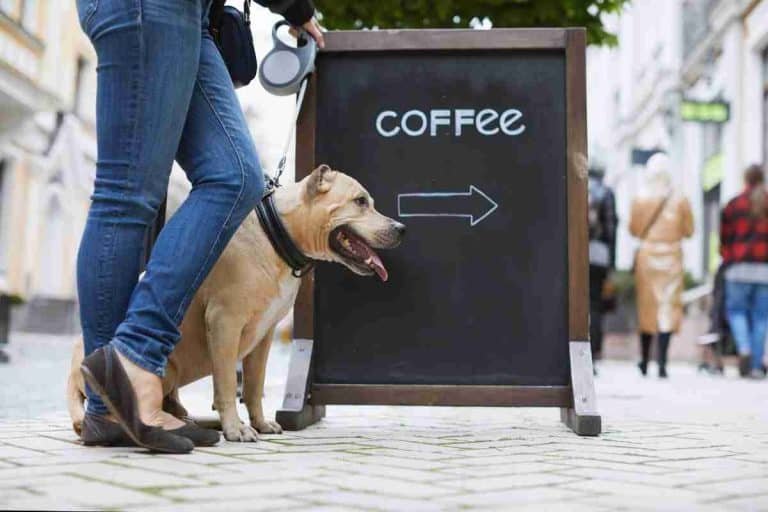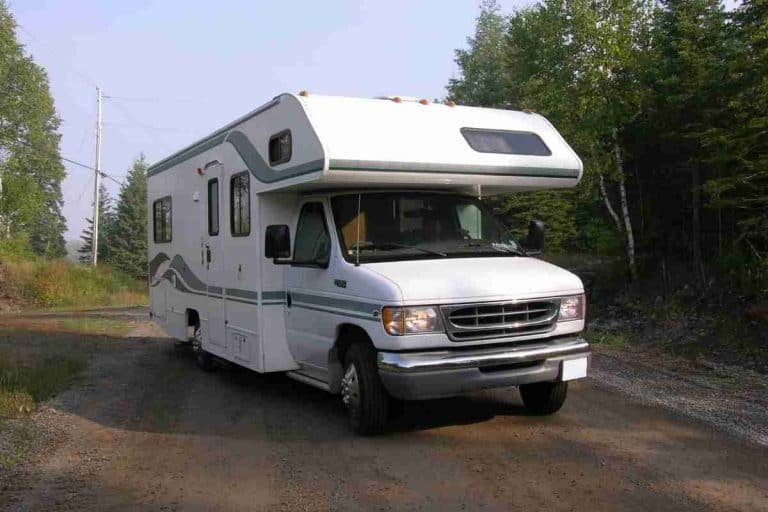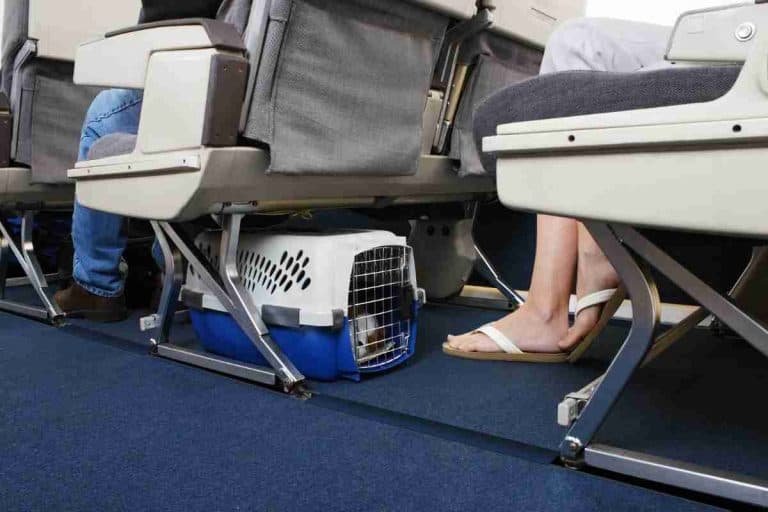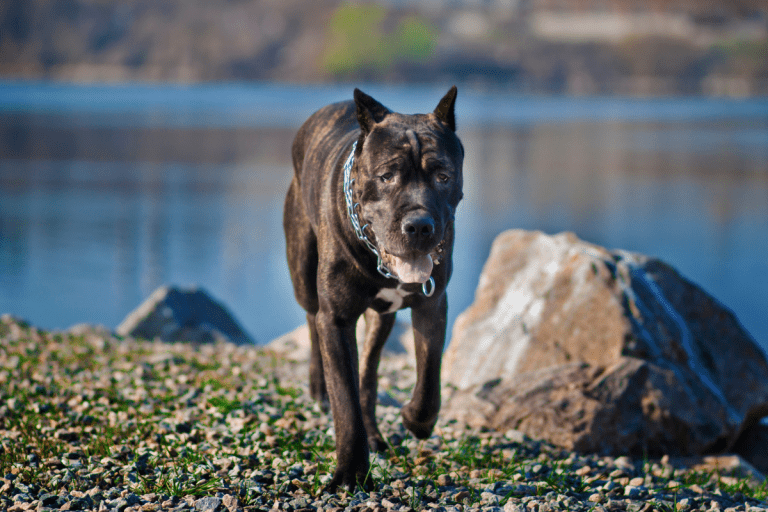Best Dog Crates for Car Travel in 2023: Crash-Tested Picks & Full Buying Guide
Affiliate Disclaimer: As an affiliate, we may earn a small commission when you make a purchase from any of the links on this page at no additional cost to you!
Last Updated on October 24, 2025
Owners seeking the best dog crates for car travel in 2023 want proven protection, not guesswork. This crash-tested buying guide filters picks using CPS references, independent lab data, and real-world mounting methods.
Readers get clear recommendations by size and use case, plus quick comparisons of safety, weight, and price. It covers fit and measurement, ISOFIX/LATCH and seat-belt anchoring, SUV cargo placement, and common failure fixes. Expect step-by-step installation tips, crate training for travel, emergency checklists, and accessories that boost safety and comfort. Choose confidently, then secure it correctly for every trip.
Top picks and short comparison
The list below focuses on crates that combine verified crash resistance, practical weight, and everyday usability. Each pick balances protection and convenience so owners can choose by priority: absolute safety, portability, or price. Use the comparisons that follow to match crate features to the dog’s size and travel habits.
For owners who want broader travel gear context—how crates fit into trip planning and vehicle setup—see Essential dog travel tips and gear for road trips. That guide explains how crate choice integrates with seat placement, harness back-ups, and ventilation.
Quick selection rules: prioritize certified crash-tested crates for highway travel; choose bolt-on or strap-mount options for repeated installs; select lightweight aluminum for frequent handling; pick soft crates only for short, low-speed trips or as supplemental carriers.
Owners should measure the dog standing and lying down before choosing. A correct fit reduces injury risk and prevents shifting during sudden stops.
At-a-glance recommendations (best overall, crash-tested, soft, budget)
Best overall: A rigid, crash-tested aluminum crate with internal tie-down points. It resists deformation, anchors securely, and offers easy cleaning. Owners who travel long distances or at high speed should favor this class.
Best crash-tested: Look for models with third-party crash certification and metal-frame construction. Those crates show predictable energy absorption under impact.
Best soft: Use breathable soft crates only for short rides or cabin travel in calm dogs. They excel at weight and stowability but lack crash protection.
Best budget: Reinforced plastic crates provide decent confinement and weather resistance for local trips. Pick one with reinforced latches and plan to add a vehicle anchoring method.
For guidance on making a crate secure in a vehicle, consult 5 ways to secure a dog crate in car. That post outlines practical mounting techniques that complement crate choice.
Best options by dog size and use case (small, medium, large, truck/airline)
Small dogs: Lightweight aluminum or molded plastic crates work well. Choose a crate that allows the dog to stand, turn, and lie down with minimal extra space to limit sliding.
Medium dogs: Rigid plastic or lightweight metal crates often balance protection and handling. Reinforced latches and built-in tie-down points matter most at this size.
Large dogs: Prioritize certified crash-tested metal crates or heavy-gauge aluminum. Large dogs generate higher forces in a crash. Strong mounts and multiple anchor points reduce movement and injury.
Truck use: For pickup beds, use ventilated metal crates that bolt to the bed or sit in a lockable shell. They must resist roll and shift during heavy braking.
Airline travel: Airline-approved plastic crates remain the standard for checked cargo. Verify box dimensions and ventilation before purchase. For more on airline rules and suitability, see airlines that allow dogs in the cargo.
Quick comparison of safety, weight, and price
Safety: Rigid, crash-tested metal crates score highest. They absorb impact and keep structural integrity. Plastic crates rank middle; soft crates rank lowest for crash protection.
Weight: Soft crates and thin-aluminum models win on portability. Heavy-gauge steel crates provide superior protection but add handling difficulty.
Price: Expect a trade-off between cost and tested safety. Certified crash-tested crates sit at the premium end. Budget plastic crates handle everyday confinement but lack crash ratings.
Buyers should compare three metrics—certification, tie-down compatibility, and mattress retention—before purchase. For practical anchoring techniques that affect safety regardless of crate type, review how to secure a dog in the cargo area of suv. That resource helps owners match crate features to vehicle mounting methods.
CTA: Measure the dog, confirm vehicle anchor points, and compare the shortlisted crates’ crash certifications before buying.
How we picked and evaluated crates
Evidence sources and crash-test references (CPS, independent labs, manufacturer tests)
The team prioritized objective, reproducible evidence. Primary sources included Center for Pet Safety (CPS) reports, independent crash-lab data, and manufacturer-submitted tests that disclose methods and dummies used. Test protocols compared deceleration profiles, anchor-point failure, and occupant movement. Reviewers required documented instrumentation and video of each crash event before accepting results.
Field reports and owner-submitted failures supplemented lab data to reveal real-world installation mistakes. For practical guidance on securing a crate inside a vehicle, consult 5 Ways to Secure a Dog Crate in Car.
Evaluation criteria: safety, fit, durability, ventilation, portability, ease of use
Each crate received scores across six weighted criteria. Safety covered structural integrity, latch retention, and certified crash performance. Fit measured internal dimensions versus breed size and vehicle footprint. Durability assessed materials, hinge strength, and fatigue resistance under load cycles. Ventilation checked airflow area and obstruction risk. Portability examined weight, foldability, and carry handles. Ease of use evaluated one-person setup, cleaning access, and compatibility with vehicle anchors. Testers referenced packing and travel tips during fit checks; see Essential Dog Travel Tips and Gear for Road Trips for related guidance.
Common failure modes discovered in reviews and tests
Repeated failures included latch shear, wall cracking at mounting points, and floor separation from side panels. Weak or improperly rated anchor straps often allowed forward rotation of the crate. Small-vent designs trapped heat; thin plastics fractured under impact. Hardware loosening over time reduced restraint effectiveness.
Mitigations focus on reinforced latches, steel-reinforced frames, dedicated vehicle anchors, and regular hardware inspections. For guidance on securing crates in larger cargo areas, review How to Secure a Dog in the Cargo Area of SUV. Testers recommend checking installation each trip and choosing crates with independent crash evidence.
Core safety features to prioritize for car travel
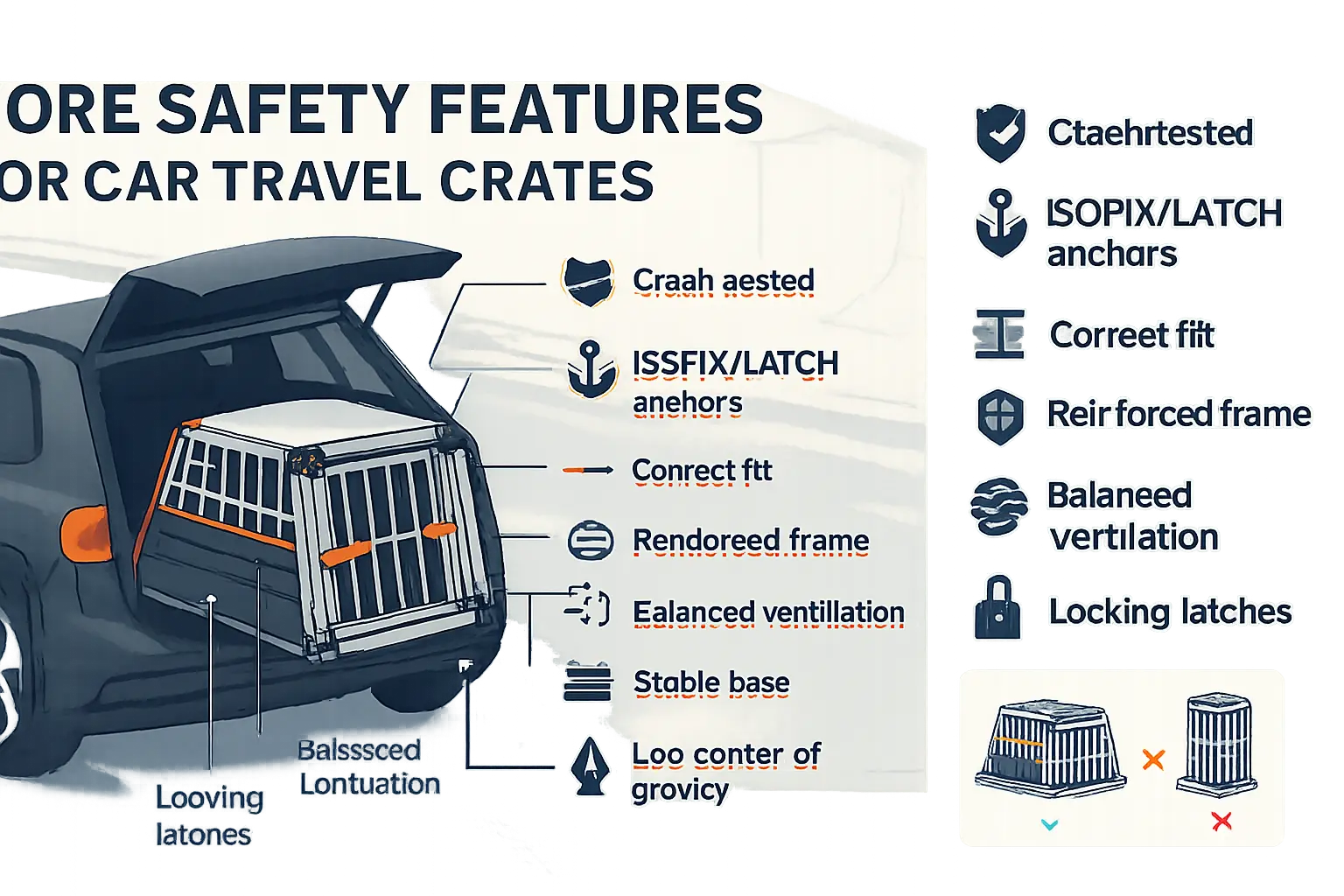
Every crate chosen for car travel must meet a short list of non-negotiable safety features. First, look for crates with documented crash-tested performance or third-party dynamic testing. Next, check reliable anchor points that allow secure attachment to the vehicle’s seat belts or ISOFIX/anchor hardware. Size and fit matter: the dog needs room to turn and lie down, but not so much space that the animal shifts violently during a crash. Durable materials and reinforced construction reduce deformation and protect the dog from intrusion and collapse. Ventilation and visibility affect stress and breathing; balanced airflow prevents overheating without creating large weak panels. Latches and door design must resist accidental opening and chewing. Ease of cleaning and a stable base reduce movement from wet or soiled bedding. Finally, consider weight distribution and center-of-gravity — low, wide crates resist tipping more effectively than tall, narrow boxes. Owners who want practical installation advice can consult detailed guides on securing crates for road use, such as this 5 ways to secure a dog crate in car. Prioritize features that protect occupants during a real collision, not only convenience or aesthetics.
What crash-test certification (CPS) actually verifies
Crash-test certification verifies how a crate behaves under dynamic loads similar to real crashes. Tests use instrumented dummies and forward-impact sled rigs to measure retention strength, energy transfer, and structural integrity. Certification checks whether anchor points hold under peak forces and whether fasteners or straps fail before the crate does. Evaluators monitor deformation of walls, doors, and latches to ensure the dog’s survival space stays intact. Some programs include side-impact or rollover scenarios, though forward-impact tests remain the benchmark. Certification also examines secondary hazards: sharp edges produced by deformation, broken hardware that could penetrate the interior, and whether interior restraints keep the dog from being ejected. Note that certification standards vary; some focus on harness-to-crate interfaces while others test crate-to-vehicle mounting. The designation does not guarantee perfection in every vehicle or with every dog size. Owners should compare certified performance to the dog’s weight and the vehicle’s anchor system, and review practical installation guidance such as risks of carrying dogs in low footwells described in Are dogs allowed to travel in the footwell of a car?
Structural elements that matter (anchor points, reinforced doors, double-wall construction)
Anchor hardware defines whether a crate will remain attached during impact. Look for bolt-through anchor points or integrated ISOFIX-compatible fittings, not just strap loops. Reinforced doors use welded frames and cross-bracing to resist inward collapse and prying. Pay attention to hinge design: external, full-length piano hinges resist shear better than short pin hinges. Double-wall construction keeps penetration risk low and spreads impact forces across layers. High-density outer shells combined with an energy-absorbing inner layer limit transmitted g-forces. The baseplate should be rigid and attach to the vehicle floor or seat anchors to prevent rotational motion. Fasteners matter: stainless steel bolts and captive hardware outperform plastic clips. Check that vents and panel cutouts don’t create large weak spots; reinforcement around openings stops tearing. Before a long trip, owners should test load points under body weight and follow vehicle-specific securing techniques; practical tips for securing crates in cargo areas can help, see How to secure a dog in the cargo area of an SUV.
Ventilation, secure latches, and anti-escape design
Ventilation must move fresh air across the dog without creating oversized openings that reduce structural strength. Multiple smaller vents or mesh panels provide airflow and preserve rigidity better than large cutouts. Consider weather and season: screens keep insects out while still allowing circulation. Latches need redundancies—primary latches that lock plus secondary catches prevent accidental openings during a crash or rough road. Self-locking mechanisms and tamper-resistant designs stop a stressed or clever dog from opening the door. Anti-escape features include inward-opening lips, overlapping door frames, and recessed latches shielded behind bars. Chew-resistant materials around latches and edges lengthen service life and reduce failure risk. Visibility matters for stress reduction; clear sightlines lower anxiety but avoid full transparency that weakens structure. Owners should balance airflow, security, and visibility for each trip. For broader travel prep and gear recommendations that complement crate choices, consult Essential dog travel tips and gear for road trips.
Types of travel crates and when each is appropriate
Choosing the right travel crate starts with use case, dog size, and trip length. Rigid crash-rated kennels offer maximum protection for long highway trips and large breeds. Collapsible and modular crates prioritize portability and storage for short drives, overnight stays, or multi-destination road trips. Soft-sided carriers and booster-style seats favor small, anxious dogs that need comfort and cabin access. Inflatable or hybrid designs target owners who need packable shock absorption, while hard plastic, airline-approved kennels remain mandatory for checked or cargo air travel. Vehicle type matters too: cargo-area setups differ from back-seat installs and require different anchor points.
Owners should match crate choice to restraint options and mounting methods. Confirm crate dimensions let the dog sit, stand, lie down, and turn around. Check material durability, ventilation, and cleaning ease. For broader travel gear guidance and packing tips, see essential dog travel tips and gear for road trips. Compare crash ratings and securement features before buying to ensure both safety and practicality.
Rigid crash-rated kennels — pros, limits and best uses
Rigid crash-rated kennels use reinforced composites or metal frames to survive impact. They often meet independent crash-test standards and provide the most consistent protection for medium and large breeds. Pros include superior structural integrity, fixed mounting points, and predictable performance in high-speed collisions. These kennels reduce forward movement and protect against intrusion from cargo.
Expect tradeoffs: weight, bulk, and cost increase. They take trunk or cargo-space room and require vehicle-specific anchoring. Some models limit airflow or interior space if owners choose undersized units. Rigid kennels work best for long interstate drives, hauling large dogs, or transporting in trucks and SUVs.
Secure installation matters as much as kennel strength. For practical mounting techniques and anchor options, consult 5 ways to secure a dog crate in car. Choose a kennel size that allows natural posture and add padding for comfort. If weight or storage is an issue, evaluate other crate types below.
Collapsible and modular crates — portability vs protection
Collapsible and modular crates trade crash protection for convenience. Lightweight aluminum frames, fabric panels, and fold-flat designs make them ideal for multi-stop trips and small living spaces. They suit short drives, hotel stays, and owners who need quick assembly. Modular systems add flexibility by letting owners reconfigure compartments for multiple pets.
Protection falls short of rigid kennels. Panels and soft joints absorb less energy during impact. Use additional restraints—vehicle straps, seat-belt adapters, or cargo-area tie-downs—to reduce movement. These crates perform well for small to medium dogs when journeys stay local and speeds remain moderate.
Install collapsible crates on a stable platform and anchor to factory tie-downs where possible. For tips on securing larger cargo-area setups, see how to secure a dog in the cargo area of SUV. Inspect latches and reinforcement points before each trip to avoid failures on the road.
Soft-sided carriers and booster-style seats — comfort tradeoffs
Soft-sided carriers offer lightweight comfort and cabin compatibility for small dogs. Padded walls, mesh ventilation, and zipper closures reduce anxiety and make entry easy. Booster-style seats elevate a dog for window views and often include tether points to clip a harness. These designs work well for short trips, vet visits, and airline cabin travel when permitted.
They provide minimal crash protection. Zippers and fabric tear under heavy loading or impact. Small dogs in soft carriers still need a properly fitted harness that attaches to the vehicle restraint system. Booster seats can increase motion and may worsen car sickness in sensitive dogs.
For guidance on easing motion sickness and making rides more comfortable, review no more doggie dramas: making car rides enjoyable for motion sick pups. Cleanable liners and chew-resistant panels improve durability. Use soft carriers only for low-speed, short-duration travel with constant monitoring.
Inflatable/hybrid designs and airline-approved plastic kennels
Inflatable and hybrid crates use air chambers or foam cores to absorb shocks while remaining packable. They suit owners who need compact storage and moderate impact mitigation. Inflatable walls cushion minor jolts, but puncture risk and variable energy absorption limit their use for large dogs or high-speed collisions.
Airlines and many cargo carriers require rigid plastic, IATA-style kennels for checked or cargo travel. Those kennels feature solid sides, metal fasteners, and standardized ventilation and labeling. They protect against compression and allow secure bolt-downs during transfers. In a car, plastic kennels still need stable anchoring and padding to limit sliding.
If air transport is planned, select an airline-approved plastic kennel and verify airline rules first. For airline-specific cargo options and policies, see airlines that allow dogs in the cargo. Consider hybrid options only for short road trips or as temporary backstage protection.
How to measure your dog and choose the right size

Choosing the correct crate size starts with accurate measurements and a clear plan for where the crate will sit in the vehicle. Sizes vary by manufacturer, so owners must measure the dog and compare results to the maker’s chart. Prioritize room for the dog to stand, turn, and lie down comfortably. Avoid oversizing that allows the dog to slide in a sudden stop.
Step-by-step measurements (length, height, weight) and common sizing mistakes
Measure length from the tip of the nose to the base of the tail. Measure height from paw to top of head when sitting or standing, whichever is taller. Weigh the dog on a reliable scale. Add 2–4 inches to both length and height for comfort. Common mistakes include measuring for length only, ignoring shoulder height, and choosing a crate based solely on breed rather than individual size.
Adjusting size for puppies and growing dogs
For puppies, measure current length and expected adult size. Choose a crate that fits adult dimensions or buy a crate with a removable divider. Dividers keep a puppy safe and prevent too much space that could encourage accidents. Re-measure every 2–3 months during growth spurts. If growth is uncertain, select a crate with modular panels or an adjustable divider.
Confirming fit in your vehicle (trunk, rear seat, cargo area, truck bed, specific models)
Measure the intended vehicle space: width, depth, and height, accounting for wheel wells and sloping roofs. Place tape markers on the floor to visualize footprint. Check that doors and hatch open fully with the crate inside. Secure the crate to anchor points or seat belts; owners can consult practical tips in 5 ways to secure a dog crate in car for common methods. Always test-fit the empty crate before buying, then confirm with the dog inside for clearance and visibility. CTA: record measurements and the vehicle fit before selecting a crash-tested model.
Installing and securing a crate safely in the car
A properly installed crate protects the dog and other occupants during normal driving and in a crash. Start by selecting a crate rated for vehicle use and matched to the dog’s weight and size. Measure the cargo or passenger space so the crate fits snugly; excessive empty space increases movement and risk. Place padding and a non-slip mat inside to reduce sliding and to absorb minor impacts. Secure the crate so it cannot shift more than an inch in any direction under firm hand pressure. Use attachment points designed for restraint systems whenever possible. When the vehicle has built-in anchors or cargo rails, attach the crate there rather than relying on seatback friction alone. Inspect fasteners and straps before every trip; webbing degrades from UV, salt and time. For step-by-step methods that illustrate common installs, see this practical guide on securing crates in vehicles: 5 ways to secure a dog crate in car
Owners should prioritize crates that allow rigid attachment to the vehicle frame or designated anchors, and verify fit with a trial drive at low speed before longer trips.
Anchoring methods: seat belt routing, ISOFIX/LATCH, cargo straps and tie-downs
Seat belt routing works well for many wire and plastic crates. Route the lap and shoulder belt through designated pass-throughs on the crate and lock the belt to remove slack. ISOFIX/LATCH systems offer stronger, lower-mounted anchors on many cars and SUVs. Use a crate or vehicle-specific ISOFIX adapter and follow torque or tension recommendations. Cargo straps and ratchet tie-downs secure crates to cargo rails, D-rings or built-in tie-down points. Use soft loops or protective pads where straps contact crate edges to prevent cutting the crate material. Choose wide webbing or ratchet straps rated above the dog’s weight and potential crash forces. For portable installs, high-quality cam-buckle straps combined with vehicle tie-downs give reliable restraint. Avoid using pet leashes, rope or low-rated bungee cords for primary anchoring. They fail to control high-energy forces during sudden stops. Refer to practical mounting examples and diagrams at this guide: 5 ways to secure a dog crate in car
Best placement advice by vehicle type and avoiding crumple zones or airbags
Placement depends on vehicle type. In sedans, place the crate on the rear seat or floor behind the rear seats, centered when possible. Avoid the front passenger seat because airbags and frontal crumple zones pose severe risks. In SUVs and wagons, place the crate in the cargo area against the rear bulkhead. That location places the crate away from frontal impact forces and allows direct attachment to cargo anchors. In pickups, secure crates in a locked, carpeted shell or use a truck bed crate with bolted tie-downs and a bed liner to prevent sliding. Minivans with built-in anchor points can accept a rear-facing crate mounted to those anchors. Avoid locations that press the crate against doors that may open on impact. Do not place a crate in front of airbags or on folding seatbacks that can collapse during a crash. For a discussion about safe footwell and seat placement, consult guidance here: Are dogs allowed to travel in the footwell of a car?
Tips to prevent sliding, tipping and seatback-dependent installs
Prevent movement by combining mechanical anchors with surface friction. Load-bearing straps handle longitudinal forces; anti-slip mats reduce lateral shifting. Wedge foam or padded blocks in gaps to limit rocking, but avoid compressible fillers that lose effectiveness in a crash. For tall crates, lower the center of gravity by removing unnecessary bedding and placing the dog so weight sits low. Use cross-tension straps to resist roll and twist rather than relying solely on the seatbelt routed over the crate. If a crate rests against a seatback, lock or block the seat so it cannot fold forward during sudden deceleration. Inspect hinge latches and welds for corrosion and repair before travel. Regularly test the installed system at walking speed; any perceptible shift signals the need to re-tension straps or add anchor points. For alternative restraint methods and trunk/cargo-specific tips, see this practical how-to: How to secure a dog in car with leash
CTA: Before purchasing, confirm that the chosen crate and the vehicle’s anchor points allow a rigid, tested installation.
Travel routines, comfort strategies and accident response
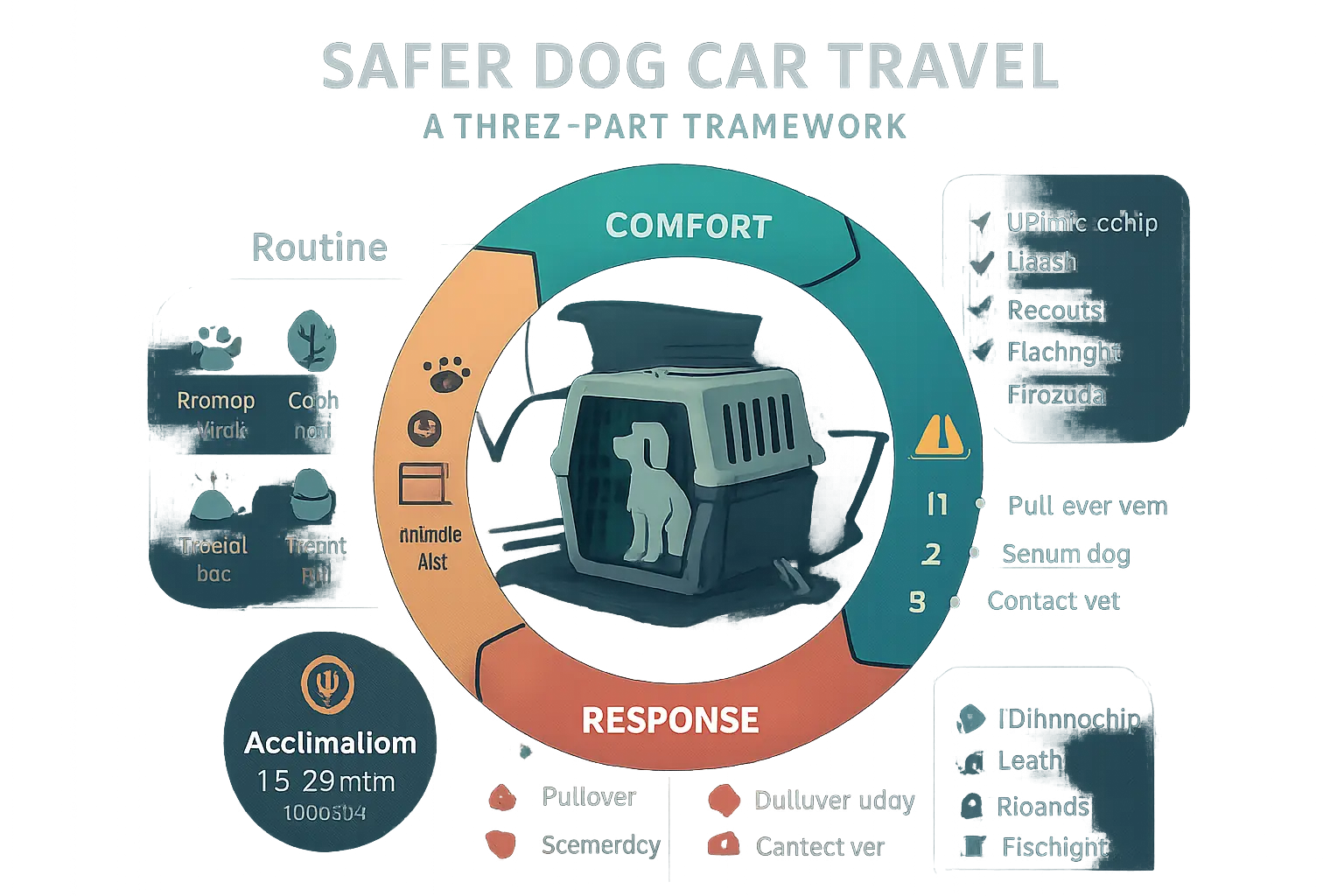
A predictable travel routine reduces stress and improves safety during car trips. Owners should set consistent pre-trip cues, short practice rides, and regular break schedules. Routines include a brief walk before loading, a calm crate-loading cue, and a post-trip reward to reinforce positive associations. Crate choice matters: choose a crash-tested model sized so the dog can stand and turn, and that fits securely in the vehicle. Keep an accessible travel kit with water, a bowl, a leash, medical records, and a blanket familiar to the dog. For dogs prone to travel anxiety, integrate behavioral tools and consult reputable sources on nonpharmacologic methods. For practical remedies and calming approaches, see natural ways to remedy your dog’s travel anxiety. Regularly inspect crate anchors and vehicle attachment points before each trip. Train for routine first-aid checks after any jarring stop and maintain emergency contacts handy. A short planning checklist reduces reaction time if anything goes wrong: confirmation of microchip and ID tag, a nearby veterinary clinic list, and photos of the dog and crate for insurance records. These routines reduce the chance of panic and speed recovery after incidents.
Getting your dog used to the crate (training steps and gradual exposure)
Gradual exposure makes the crate a safe, predictable space. Start by placing the crate in a quiet room with the door open. Scatter high-value treats and a familiar blanket inside. Allow the dog to explore freely for short sessions, then close the door for a few seconds while offering treats. Increase door-closed time in small increments until the dog accepts 15–20 minute sits. Next, practice short car rides with the crate tethered but stationary, then with the vehicle moving slowly around the block. Keep sessions positive and end before the dog shows stress. Use a calm, consistent cue when it’s time to load. If the dog resists entry into the car or crate, consult focused resources on overcoming that specific behavior, such as advice for dogs refusing to get into the car. Never rush training or punish anxiety; that increases avoidance. For larger dogs, break tasks into smaller, achievable goals and reward every cooperative step. Short, frequent sessions work better than long, infrequent ones.
In-trip care: breaks, hydration, temperature control and calming tools
During travel, maintain comfort and safety with scheduled breaks every 2–3 hours. Offer water in small amounts to prevent nausea. Use a spill-proof bowl or a bottle designed for travel. Monitor temperature closely: never leave a dog unattended in a parked car. On warm days, aim to keep the cabin below 75°F; on cold days, add insulated bedding. Provide airflow by placing the crate where vents reach it, and avoid direct sun exposure. Calming tools can help: a lightweight anxiety vest, chew-safe enrichment toys, and familiar-smelling bedding reduce stress. Use pheromone sprays or diffuser pads inside the crate for dogs who respond to them. Avoid sedatives unless a veterinarian prescribes them; sedated dogs face airway and balance risks during collisions. Pack a small cooling mat for hot weather and a thermal blanket for cold. For practical packing and gear suggestions suitable for road trips, consult essential dog travel tips and gear for road trips. Keep breaks calm and brief to preserve the dog’s routine.
After a crash: checklists for safety, securing your dog, vet care and insurance steps
Immediately after any collision, prioritize human safety, then the dog. Pull over safely, put the vehicle in park, and secure hazard lights. Approach the dog calmly; treat them as potentially injured and stressed. If the dog is alert and mobile, move them to a secure area away from traffic. If unsure about spinal or limb injuries, avoid moving the dog; instead, stabilize them in their crate and call emergency veterinary services. Photograph the crash scene, vehicle damage, the crate, and the dog’s visible injuries. Obtain a police report and contact the insurance provider promptly to report the incident and request guidance on documenting vet bills. Check crate mounting points for failure—broken anchors mean the crate must be retired. Replace damaged crates with crash-tested models and improve restraint methods. For techniques to better secure crates and reduce future risk, review ways to secure a dog crate in car. Keep medical records, microchip data, and recent photos ready for claims. Finally, schedule a veterinary exam even if injuries seem minor; internal trauma can appear delayed.
Buying checklist and frequently asked questions
The section condenses practical criteria buyers use to choose a car-safe crate and answers the most common safety questions. Focus stays on crash performance, secure mounting, and fit. Prioritize crates that list crash-testing results or that manufacturers certify for automotive use. Materials should resist deformation under force and keep the dog contained without sharp edges.
Other key considerations include door latch strength, reinforced floor, ventilation that won’t collapse, and easy, secure tie-down points. Match interior dimensions to the dog’s standing height and length, then add 2–4 inches for comfort. For mounting, prefer vehicles with anchor points rated for child seats or consult methods proven for crate restraint.
For practical techniques to anchor a crate and reduce movement during driving, consult this guide on securing crates: 5 ways to secure a dog crate in car.
Buyers should keep a checklist on hand when testing crates in-store or at home. If a model shows brittle plastic, flimsy welds, or latches that shift under pressure, flag it. Record fit, weight, and mounting options before purchase.
Compact buying checklist you can use at the store (must-have specs and red flags)
Use this short, actionable checklist in the aisle to judge a crate quickly. Start with must-have specs, then scan for red flags.
- Must-have specs: reinforced polymer or aluminum frame; documented crash-testing or automotive-rated label; secure, multi-point door latches; integrated or clearly designated tie-down points.
- Size and fit: dog must stand, turn, and lie down comfortably; measure dog from nose to tail and floor to top of head before testing the crate.
- Ventilation and visibility: ample venting on at least three sides without thin, easily collapsed panels.
- Easy cleaning: removable, durable pan or floor with sealed seams.
Red flags: thin wire that bends, single-point latches, glued corners, no anchor options, or interior trims with sharp edges. Avoid soft-sided carriers for regular car use unless they explicitly list crash-test certification.
When checking mounting compatibility with a vehicle, review practical securing techniques used in cargo areas: how to secure a dog in the cargo area of suv. That resource helps determine if the crate’s mounting points match vehicle anchors.
FAQs: Are wire or soft crates safe in a crash? How long can a dog stay crated? Harness vs crate?
Are wire or soft crates safe in a crash? Wire crates and soft-sided carriers rarely offer meaningful crash protection. Wire can deform and allow ejection; soft crates collapse under high forces. Only hard-sided designs with documented crash-testing or purpose-built automotive crates provide reliable containment.
How long can a dog stay crated? Healthy adult dogs tolerate 2–4 hours of continuous crating on the road, with breaks to hydrate, relieve themselves, and stretch. Puppies, elderly dogs, or dogs with medical issues need shorter intervals and more frequent stops. Long trips require planning for rest and exercise every few hours.
Harness vs crate? A crash-tested restraint harness can protect dogs when properly fitted and used with vehicle-approved anchors. Crates provide a more complete enclosure and protect from projectiles and sudden movement. For long-distance trips, crates often reduce fatigue and motion stress; for short trips, a certified harness may suffice. Owners should choose options rated for crash scenarios and sized for the dog.
For guidance on transporting dogs without a crate, including harness alternatives and puppy handling, see: how to transport a puppy in a car without a crate.
Helpful accessories (tie-down kits, pads, ventilation covers, emergency kit)
Good accessories increase safety and comfort. Prioritize secure, automotive-grade tie-down kits that attach to the crate’s reinforced points and to vehicle anchors. Avoid flimsy straps; use rated hardware and metal buckles.
- Tie-down kits: choose straps with load ratings and metal hardware. Confirm fit to crate anchor points before travel.
- Padded flooring: use thin, non-slip pads that won’t bunch under sudden braking. Thick bedding can shift and impair restraint effectiveness.
- Ventilation covers and shades: lightweight covers reduce glare and heat but must not block airflow or collapse onto the dog.
- Emergency kit: include a leash, collapsible water bowl, bottled water, basic first-aid items, spare crate latch, flashlight, and copies of vaccination records.
Test all accessories off-site to ensure they don’t interfere with latches or ventilation. For broader travel gear and road-trip packing lists tailored to dogs, consult: essential dog travel tips and gear for road trips. Buyers should confirm accessory compatibility with the chosen crate before completing a purchase.
Summary
Best Dog Crates for Car Travel in 2023: Crash-Tested Picks & Full Buying Guide helps owners choose safer, easier-to-use travel crates by blending verified crash data with real-world installation advice. It explains how to prioritize certified, rigid designs, match crate size to the dog and vehicle, and anchor the setup using seat belts, ISOFIX/LATCH, or cargo tie-downs. The guide also clarifies when plastic, collapsible, and soft options fit short or local trips, and it flags the limits of non-rigid crates at highway speeds.
Readers leave with a practical framework: measure the dog, confirm vehicle anchor points, and compare certifications and hardware before buying. Placement tips by vehicle type, common failure modes, training and comfort routines, and a compact in-store checklist make the final choice—and safe installation—straightforward.
Key Takeaways
- Prioritize certified, rigid crates (aluminum or reinforced metal) for highway travel—especially for medium and large dogs—to maintain structure and prevent ejection.
- Size correctly: measure nose-to-tail and floor-to-head, add 2–4 inches, and avoid oversizing that increases sliding and injury risk; confirm the crate fits the intended vehicle space.
- Secure the crate to the vehicle using seat belt routing, ISOFIX/LATCH, or rated cargo straps; limit movement to under an inch and avoid bungees, rope, or leashes.
- Place away from airbags and crumple zones: rear seat or cargo area against a bulkhead is preferred; lock seatbacks and use non-slip bases to prevent tipping or rotation.
- Check critical features: reinforced latches and doors, real tie-down points, sturdy base, balanced ventilation, and materials that resist deformation; inspect hardware before each trip.
- Match crate type to the trip: rigid crash-rated for long/high-speed drives; reinforced plastic for short local runs; collapsible/soft only for low-speed, supervised rides.
FAQ
-
What makes a crate “crash-tested,” and which certifications matter?
Crash testing uses instrumented dummies on sled rigs to verify retention, deformation, and anchor strength. Look for documented methods and results from CPS or independent labs; confirm that testing covers the dog’s weight range and the crate-to-vehicle interface. -
How should a crate be secured for maximum safety?
Attach to factory anchors with seat belt routing, ISOFIX/LATCH, or rated cargo straps and cam/ratchet buckles. Remove slack, protect strap contact points, and ensure the crate cannot shift more than an inch in any direction. -
Why is correct sizing so important for car travel?
Proper fit limits momentum and reduces injury risk during sudden stops. Measure length and height, add 2–4 inches, and avoid excess interior space that allows the dog to slide. -
How do soft or wire crates compare to rigid designs in a crash?
Soft and wire crates often deform or tear under impact and can allow ejection. Rigid, crash-tested metal or reinforced plastic crates provide predictable energy management and stronger containment. -
What’s the best budget-friendly option for short/local trips?
Reinforced plastic crates with strong latches and proper tie-downs can work for local, low-speed drives. For long or high-speed travel, choose a certified, rigid model instead.


